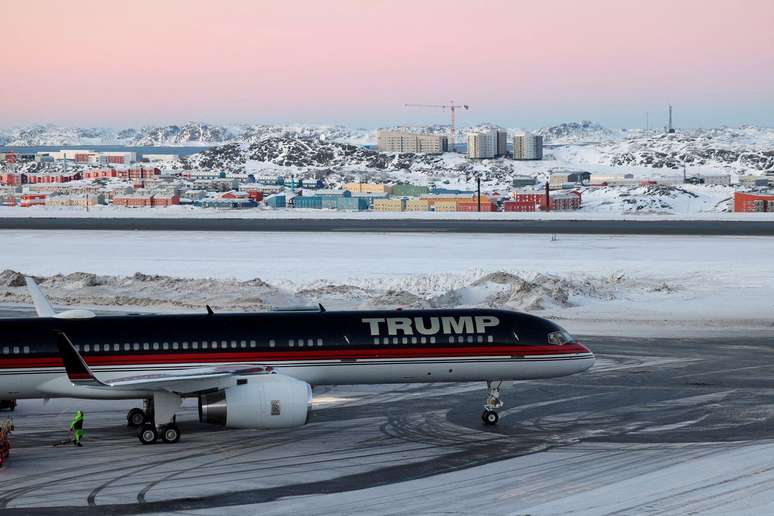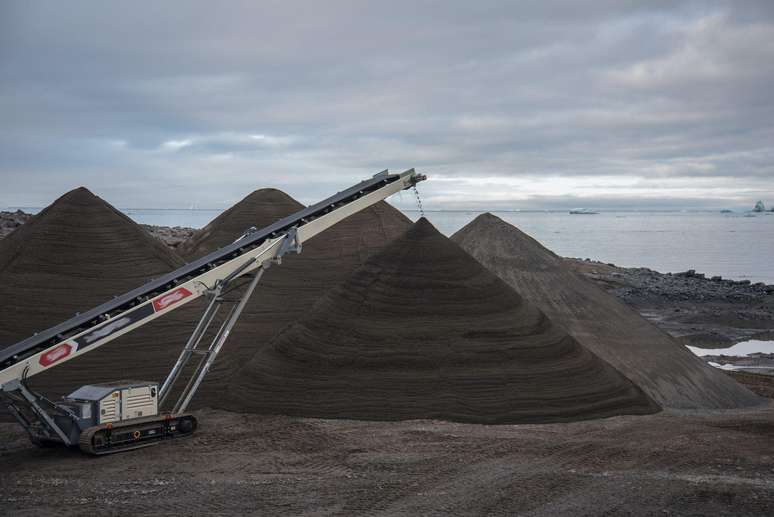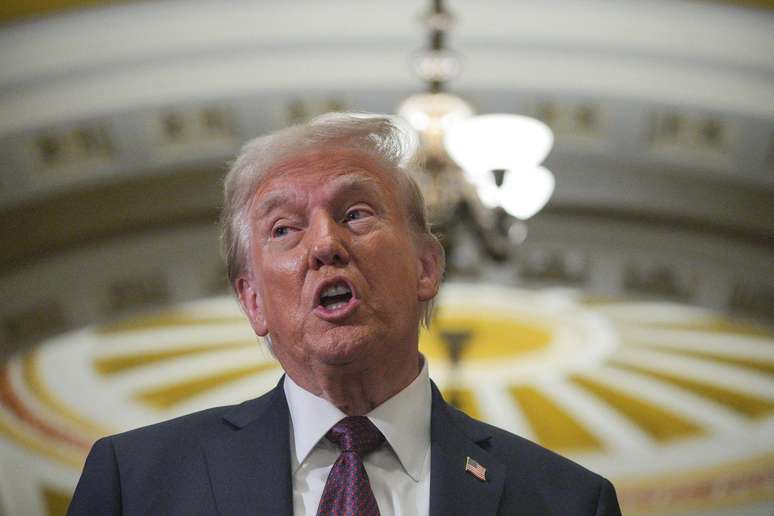Since 2019, Trump has mentioned plans to annex Greenland, but the number of references suggests that Republican interest has increased. Rare earths and other minerals, whose production is led by China, could be the key to understanding the expansionism of the newly elected American president.
In recent weeks, the president-elect of the United States, Donald Trump, has expressed expansionist intentions against multiple objectives.
The Republican said Canada should become the 51st state of the United States, calling the Panama Canal the “United States Canal,” and suggested renaming the Gulf of Mexico the “Gulf of America.” But no territory seems to have received as much greed as Greenland.
On Tuesday (1/7), in a press conference at Mar-a-Lago, Trump even said that he could not rule out the use of military force to gain control of Greenland or the Panama Canal.
“We need both for economic reasons,” Trump said.
But in the case of Greenland, Trump went further: “We need Greenland for national security purposes.”
The island – the largest in the world – is an autonomous territory of Denmark, which colonized the region.
The Republican argues that the European country should give up interfering in the territory to, in his words, “protect the free world” and has threatened to impose tariffs on North Atlantic Treaty Organization (NATO) ally Denmark if the country did not do so. don’t give up.
“It’s an agreement that must happen”, suggesting that he is willing to make some sort of purchase of territory.

On social media, sharing photos of his son, Donald Trump Jr., visiting Greenland’s capital, Nuuk, Trump adapted his political slogan to apply to the island: “Make Greenland great again.”
Despite the negative Danish reaction, reiterating that the territory is not for sale, Greenland Prime Minister Múte Egede said it is time for Greenland to break with “the shackles of the colonial era”, referring to Denmark. But he also said the island’s population of fewer than 60,000 was “fighting for independence.”
Trump’s plans for Greenland aren’t exactly new. “It would be a great real estate deal,” he said in 2019, during his first term, when he first declared his interest in the island.
At the time, however, he said that acquiring the area was not his priority.
At the time, then-White House economic adviser Larry Kudlow, in an interview on “Fox News Sunday,” was clearer about what the Trump administration saw in the island.
It’s “a strategic location” with “many valuable minerals,” Kudlow said.
Management representatives even approached the Danes to try to conclude a deal, which did not happen.
Rare earths
If the idea existed before, Trump’s number of hints on the topic now, as he forms his government that takes office on January 20, suggests that Greenland has gained a position of importance in the country’s future plans. Republican.
Experts are betting this has to do with the recent mapping of Greenland’s mineral riches and the changing economic dynamics related to them.
Historically the territory has received the attention of American authorities due to its strategic position. First, as a way to contain the global advance of the Nazis during World War II. Then, during the Cold War, to control the sea routes between Europe and North America and due to its proximity to the Arctic.
The U.S. military has operated Pituffik Space Base, formerly known as Thule Air Base, between the Atlantic and Arctic oceans for decades. The base is used as a ballistic missile observation outpost.
But a report published in mid-2023 by the Geological Survey of Denmark and Greenland estimated that the 400,000 km2 of the island currently not covered by ice has moderate or high deposits of 38 minerals on the European Commission’s list of critical materials.
In addition to apparent high concentrations of copper, graphite, niobium, titanium and rhodium, there would also be large deposits of so-called rare earths, such as neodymium and praseodymium, whose peculiar magnetic characteristics make them fundamental in the manufacture of electric vehicle engines. and turbines.
“Greenland could contain up to 25% of all rare earth element resources in the world,” geologist Adam Simon, a professor at the University of Michigan, told BBC News Brasil.
This would equate to approximately 1.5 million tonnes of materials.

Dispute with China
Rare earths have become an in-demand element in an energy transition context in search of clean and renewable forms of energy – to contain climate change – and have launched several global powers into disputes over large mines of these elements around the world .
“By 2024 we will be using around 4,500% more rare earths globally than in 1960,” says Simon, who continues: “even if mining in Greenland becomes feasible in a short period of time, we will still need more reserves of rare earths to meet current market demand”.
Currently, China dominates the rare earth mining and processing market. The Chinese are responsible for approximately ⅓ of the known reserves, 60% of the extraction and 85% of the processing of these products. But Chinese dominance of this market has already reached 95% in 2010, which has given Beijing considerable political and economic power over central production chains in Europe and the United States.
Currently, the two mining companies prospecting for rare earths in Greenland are Australian, but one of them has China’s Shenghe Resources, a Chinese state mining company, as an investor.
China has been trying to strengthen its presence in Greenland for years. Xi Jinping has defined China as a country “close to the Arctic”, even though the country is almost 1,500 kilometers from the region and, in addition to cultural and technological projects, they have tried to take root in the island through construction works. An infrastructure called Polar Silk Road, an arm of Xi’s massive global investment project called Belt and Road.
Under this program, Chinese construction companies tried to build at least two airports in Greenland, but ended up being overtaken by Danish firms, in a dispute in which Washington allegedly exerted pro-Danish pressure.
All these Chinese movements in the area have alarmed the United States, which has China as its main global antagonist. In its first term, the Trump administration included rare earths among materials critical to American national security and signed cooperation agreements for technological and scientific development between Greenland and the United States.
The growing presence of scientists, researchers, politicians and military officers in the region in recent years does not appear to be sufficient to guarantee any American exclusivity over the island’s natural resources, nor does the current Biden administration appear to have pursued such an attempt.
Twelve days after leaving office, current Secretary of State Antony Blinken said that Trump’s plans for Greenland “will not get done” and that it would be a waste of time to discuss the issue.
Moss and Manifest Destiny
If the interest in rare earths and Greenland was already clear in the first term, the fact that the direction of the second Trump administration is profoundly influenced by billionaire Elon Musk, CEO of Tesla, one of the largest electric car manufacturers in the world, should not be ignored.
“Certainly Tesla has an interest in the global availability of rare earth elements in addition to lithium, copper, nickel and graphite. So it is reasonable to think of a conflict of interest if the CEO of a company that depends on the availability of critical mineral elements is in a political position of authority to make decisions that could impact the global availability of these minerals,” says Simon.
The same prudence, however, also recommends caution within the limits of the immediate benefits for Musk, and for Trump himself, in the attack on Greenland.
“In the current state of mineral exploration, it is highly unlikely that we will have miners capable of producing commercially in Greenland in less than 10 years,” says Simon.
“While governments operate with a 4-year horizon, these large mining companies plan their business with a 40-year horizon,” adds the geologist.
While it is possible to greatly speed up mining in the island areas, a second challenge would be to transport production by large ships to a relatively remote region filled with icebergs and other nautical challenges. Therefore, it is unlikely that Trump can boast of mining rare earths on a Greenlandic scale, even if he were to overcome the enormous geopolitical challenges of the task.
The key to understanding Trump’s motivations on the issue may lie in another historical element of American international politics: the doctrine of manifest destiny. This is what the editor of the right-wing magazine “The American Conservative”, James P. Pinkerton, argued in 2019.
The notion of Manifest Destiny, articulated in the 19th century, asserted that, given its “exceptionalism,” the United States had the duty and right to advance into foreign territories to ensure the development and expansion of the experiment in freedom and self-government that the United States had undertaken. recommended country. This included securing resources to support the economy and ensure the country’s security.
Manifest Destiny was the ideology behind the expansion of the Americans from the 13 colonies to the West, which, among other things, displaced many of the Native American populations from their lands, which led to the genocide of many of them.
The world order established after the Great Wars, with the creation of multilateral bodies to mediate disputes between nations (frequent targets of Trump’s criticism) and the establishment of clear borders between countries, seemed to have put an end to territorial expansion called for by Destiny Manifest.
One of the greatest examples of this movement was Andrew Jackson, the seventh American president, who ruled from 1829 to 1937. It is no coincidence that Trump claims to have great admiration for Jackson.
During his first term, one of the first changes the Republican made to the Oval Office, the traditional office of American presidents, was to hang a painting of Jackson in the room.
Now in his second term, Trump appears to have reserved much more for Jackson than a place on the wall.
Source: Terra
Rose James is a Gossipify movie and series reviewer known for her in-depth analysis and unique perspective on the latest releases. With a background in film studies, she provides engaging and informative reviews, and keeps readers up to date with industry trends and emerging talents.






